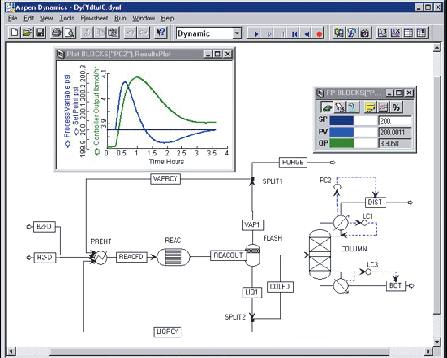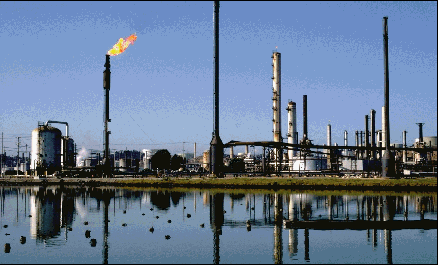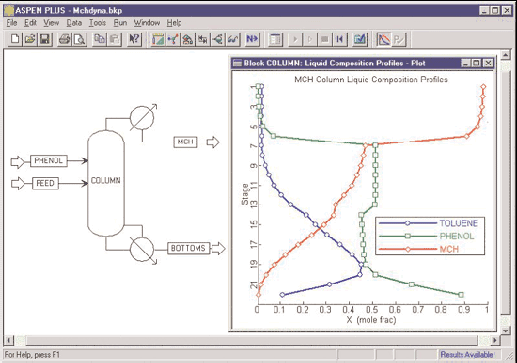工艺流程动态模拟软件Aspen Dynamics
Aspen Dynamics complements the steady-state simulation capabilities of Aspen Plus and delivers the benefits of dynamic modeling to the Petrochemicals, Chemicals, and Specialty Chemicals industries throughout plant operation and engineering organizations.
(一)The Challenge: Understanding and Predicting Dynamic Behavior
The process industries are faced with an increasingly competitive environment, ever-changing market conditions, and government regulations; yet, they still must increase productivity and profitability. These business objectives are achieved by reducing the time required to get new products to market, increasing the quantity and quality of product produced, operating the plant more safely and efficiently and/or designing plants for an optimum performance along their lifecycle..
In the chemical process industries, operational efficiencies, production economies, product quality and, ultimately, bottom line performance can be adversely affected by a multitude of factors. Many of these factors are extremely complex and subject to varying degrees of unpredictability. To avoid production delays, downtime or off-spec product, process manufacturers require cost-effective tools that help identify and ‘correct’ anticipated problems before they occur.
Process engineers routinely address difficult manufacturing and production issues. Unfortunately, experience alone is not always sufficient to answer the questions that continually arise – and ‘trial and error’ efforts to provide meaningful insight are usually cost-prohibitive (if not occasionally risky).
(二)The Opportunity: Linking Business Operations and Process Operations
Dynamic plant simulation is a powerful tool that helps managers and engineers link business operations to process operations, thus enabling true Process Lifecycle Management? (PLM?). Dynamics simulation enables chemical manufacturers to:
- Ensure safety. Predict the consequences of equipment failures, power failures or other operational problems and ensure that a plant is designed to safely handle such events.
- Ensure environmental compliance. Guarantee that process disruptions will not result in unacceptable plant emissions.
- Improve operability. Ensure that a plant has sufficient built-in flexibility to move between different operating points in a minimum of time – without producing off-spec products.
- Improve start-ups and shut-downs. Help ensure trouble-free commissioning, start-up and shutdown, where improvements can have a direct impact on the bottom line.
- Achieve consistent product quality. Ensure that the control scheme will properly handle disturbances and thereby reduce production of costly off-spec product.
- Troubleshoot operational problems. Understand the cause of operational problems as the first step toward solving them. Process engineers require safe, cost-effective ways to test proposed solutions before implementing them in a plant.
- Optimize batch process operations. Understand the operational behavior of a batch process and thereby determine how to minimize batch times and maximize yields – for enhanced bottom-line performance.
(三)The Solution: Aspen Dynamics
To understand the dynamic behavior of a complex chemical process, process manufacturers require a dynamic process
simulator. Aspen Dynamics? is a state-of-the-art solution designed specifically for dynamic process simulation. Aspen Dynamics is tightly integrated with Aspen Plus?, AspenTech’s steady-state simulator for the chemical process industries. This integration enables users to use an existing Aspen Plus steady-state simulation and quickly create a dynamic simulation. This enables users to fully leverage their existing investments in steady-state Aspen Plus models and ensures consistency with their steady-state simulation results.

(四)Benefits Offered by Aspen Dynamics
With applications across the chemical process manufacturing lifecycle, Aspen Dynamics helps companies improve
productivity and profitability. Its dynamic models are useful throughout the operational life of the plant, thus extending the value of engineering completed during the design phase. Aspen Dynamics supports concurrent process and control design, which helps reduce capital costs, lower operating costs, improve plant safety and prevent control problems. Some of the key uses of Aspen Dynamics are listed below:
(1) Improve Process Design
The traditional method of designing processes depends heavily on steady-state analysis. Operability and control issues are usually addressed after the process has been fully developed. Aspen Dynamics enables companies to consider steady-state process performance and operability issues in parallel. Examples of questions that Aspen Dynamics addresses in process design include:
- We are designing this plant with tight heat integration in the distillation train. The steady-state results show great energy savings with this design. Is the process operable? What happens as we increase or decrease throughput? Where must we place supplementary heaters and coolers to ensure operability of the process?
- We are designing the reactor and its cooling system for an exothermic reaction. We must evaluate these designs against multiple scenarios. What happens if excess reactant is in the feed? What happens if excess catalyst is added? If we have loss of coolant, how fast must we turn off the feed to avoid runaway reaction and over-pressure?
- We are designing a new process with multiple reactors, columns, and reactant recycles. Based on our experience with a similar process, we are anticipating serious challenges in the plant-wide control of this process. We need a rapid evaluation method for assessing the operability of different process alternatives. Can we evaluate steady-state performance and control issues side-by-side with a single technology to expedite our process design?
(2) Solve Operational Problems
Regardless of the process development and design effort, operational problems exist and directly impact the profitability of a plant. Examples of problems Aspen Dynamics solves include:
- Our plant has a problem with controlling column K-102. Should we change the control strategy or install a feed tank to reduce feed disturbances?
- We know that the good feed stage for the column is different for each feedstock we use, but we don't want to switch
feed trays because we are concerned that the control system will not maintain the product purity during the switch. How can we test out the feed tray switching strategy before implementing it in the plant? 
- Each time we take this plant section through a major throughput change, the plant operators and engineers must work for 14 hours to bring the product back on spec. How can we develop a control strategy to achieve smooth and automated throughput transitions?
- Our plant has operational problems because trace components are accumulating over time. How can we alter the process and its control strategy to eliminate the performance degradation and process upsets that we are currently encountering?
(五)Aspen Dynamics Usage Example
Extractive Distillation Composition Control:A customer was required to make 98% pure methylcyclohexane (MCH) from a mixture of MCH and toluene. These components form a close-boiling system that is difficult to separate by simple binary distillation. Phenol was selected as the extractant to enhance the relative volatility of MCH over toluene.

Using Aspen Plus, the column is designed with the MCH-toluene mixture feed on stage 14 and the phenol feed on stage seven. Dynamic simulation using Aspen Dynamics indicates that the stage temperatures are much more sensitive to the phenol
concentration than to the toluene concentration in the upper section of the column. Based on this, it was determined that column temperature was not a suitable variable for controlling the amount of toluene in the distillate and a composition analyzer would be required to control MCH purity.
An MCH composition controller that manipulates phenol flow rate is added to the Aspen Dynamics model. Dynamic simulation is then used to simulate both the process response and the dynamic performance of the control system, including the dead time associated with the analyzer. The column dynamic behavior was then simulated in Aspen Dynamics to determine the ultimate period and gain for MCH purity. This enabled the good tuning parameters for the purity controller to be determined. As a final test, a composition disturbance was introduced in the MCH-toluene feed to determine how well the controller would handle feed upsets. Aspen Dynamics was used to simulate a step change increase from 50% to 55% toluene at. The results show that the control strategy met the control objectives.

(六)Aspen Dynamics Features
In order to operate with maximum effectiveness and provide the necessary insights and knowledge, a dynamic simulator
must combine ease-of-use with robust engineering power. Aspen Dynamics is built upon proven technologies, with more
than 20 years experience supplying dynamic simulation tools to the chemical process industries, and provides the
following features:
- 3-phase and reactive distillation, including user-specified reaction kinetics.
- Rigorous modeling of distillation column hydraulics and pressure drop for both tray and packed columns.
- Vapor holdup modeling that ensures accurate results for high-pressure processes (including processes with high-pressure distillation columns) and applications such as pressure relief.
- Option to choose simpler flow-driven simulations or more rigorous pressure-driven simulations. Pressure-driven simulations relate the flows around the flowsheet to the pressures in each unit operations. This capability is essential for simulation of pressure relief, steam networks, compressor systems and many other applications.
- Usage of the physical property models and data available in Aspen Properties? – AspenTech’s physical property system - to facilitate consistent use of properties across the enterprise. Dynamic simulations use continuously updated local property correlations to deliver high performance without loss of accuracy.
- Support for polymer processes via Polymers Plus? – AspenTech’s general-purpose polymer process modeling system.
- Open models created using Aspen Custom Modeler? – AspenTech’s model authoring technology – to enable companies to capture their specific expertise and proprietary knowledge.
- Several models and other features for simulation of pressure relief systems, including pipe, bursting disk and pressure
safety valve models. The stirred tank reactor can model frothing and liquid carryover in the relief.
- Advanced, equation-based solution techniques and state-of-the-art numerical methods to ensure fast, reliable and accurate simulation solutions. The implicit integrator ensures stable solution of the dynamic simulation and varies the integration step to ensure accuracy while maximizing performance.
- A dynamic optimizer for quick and easy dynamic optimization of conventional unit operations and processes.
(七)The Goal: Reduced Costs and Improved Profitability
Aspen Dynamics brings dynamic simulation to the engineering desktop and superior modeling power and ease-of-use to
the chemical process industries – enabling companies to design and operate more efficient, safer and more profitable process plants.
(八)AspenTech: A Tradition of Innovation
Aspen Technology Inc.'s proven, integrated software and rapid implementation services enhance the efficiency and profitability of process companies. AspenTech's engineering software optimizes process designs to maximize lifecycle returns. Our manufacturing/supply chain software harmonizes production, inventory, demand, and delivery to improve operating margins. Together, these offerings create an integrated solution – enterprise operations management (EOM) – that transforms enterprise-wide operating performance.
"Aspen Dynamics functionality has been used to model a complex vapor relief scenario and has proven to be very powerful in its functionality and performance. Rigorous modeling of the reactor section with Aspen Dynamics has resulted in increased understanding of its behavior under relief conditions. In addition, the model has been used for optimization of normal operating conditions, resulting in significant savings on variable costs."




